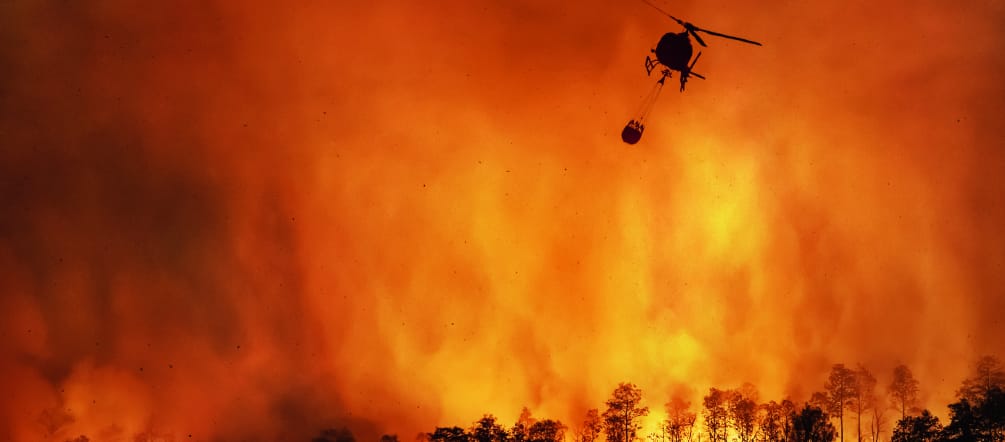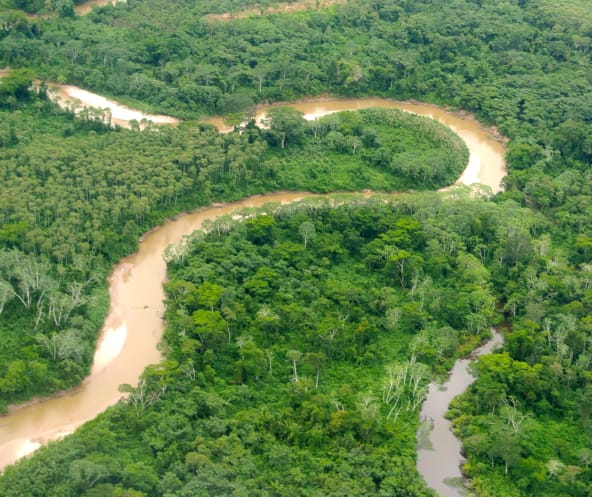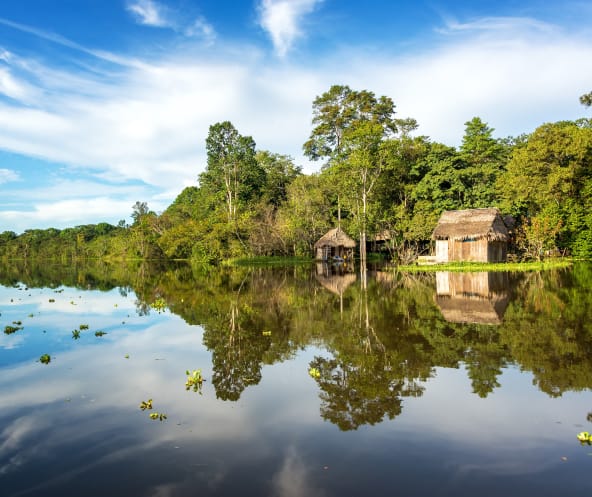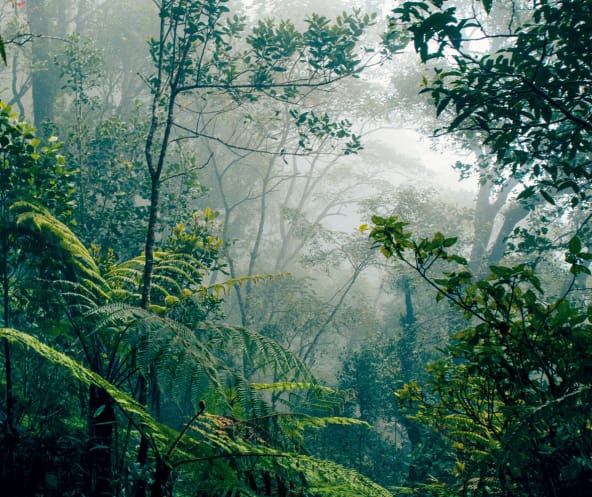
The climate crisis and extinction
Forest fires, floods, droughts and heat waves – we are feeling the impact of the climate crisis, at home and around the world. The mass extinction of animal and plant species is less apparent, even though a million species are on the brink. Yet the two existential crises are tightly interwoven and reinforce each other. We must tackle them together.
We humans have a knack for destroying things. Let’s take the climate: We’re releasing greenhouse gases into the atmosphere as if there is no tomorrow. We ignore scientists who have spent decades warning us about the climate catastrophe we are causing.
But simply trashing the climate does not seem to be enough for us: We are also destroying the diversity of life on our planet. Human activity such as clearing rainforests is robbing countless animal and plant species of their habitat.
A double threat to chimpanzees, bonobos and gorillas
Endangered chimpanzees, bonobos and gorillas are hanging in there on the brink of extinction. We could save them, and countless other species, if we were to protect their habitat.
But that will not be enough: The climate crisis could still wipe them out. Turning up the global heat is not only making primates sweat, it is also robbing them of their accustomed spaces. Working only to preserve previous habitat will then not be enough.
This example shows how closely climate and biodiversity are linked – a connection that is often overlooked.
Extinction – one million species on the line
The UN estimates that a million species could disappear from the face of the Earth in the near future. Ecosystems are at risk on 75 percent of the Earth’s land area. Coral reefs and rainforests are particularly hard hit. The Earth has already experienced five mass extinctions – the previous one marked the end of the dinosaurs that had ruled the Earth for many millions of years. In a sense, evolution started over at that point. Now, for the sixth time, biodiversity is collapsing – this time humans have triggered the drama with their reckless treatment of nature.
However, in connection with the current mass extinction, the changing climate is only being discussed as a marginal issue. This is a mistake, because catastrophic climate change not only causes floods, heat waves and extremely cold winters, it also fundamentally changes the living conditions of animals and plants around the globe.
The climate is also crucial for the future of Africa’s great apes: The rise in temperature and increasing droughts is impacting the range of available plants, and thus the apes’ food supply. According to new research, their living space will shrink by 85 percent even if we succeed in limiting the global rise in temperature to 1.5°C. If we fail, their habitat will disappear almost completely. Whether our closest animal relatives become extinct thus also depends on how seriously we take climate protection.
The climate crisis and mass extinction are caused by humans
The situation described above for primates holds true as a general rule: The climate crisis and mass extinction are two man-made, existential crises that are occurring simultaneously with numerous interactions. Neither can be deemed less dangerous or lower-priority. We must tackle them together.
How tightly the climate and biodiversity are intertwined can be studied in the rainforests. No other ecosystem on Earth has more animal and plant species. More tree species thrive on one hectare of Yasuní National Park in Ecuador than in all of North America. More insect species can be found on a single ancient rainforest tree than in all of Europe. As carbon sinks and rainmakers, intact forests play an important role in regulating the climate and are crucial to the fight against catastrophic climate change. Plants absorb the greenhouse gas carbon dioxide (CO2) from the air and store it over the long term.
The rainforest as a carbon sink
An estimated 250 billion tons of CO2 are stored in rainforests, much of it in peat forests. Globally, this is equal to 90 times the man-made greenhouse gas emissions per year. 40 percent of the oxygen in the atmosphere comes from rainforests. While the metaphor of forests as the “lungs of the Earth” does not fit perfectly, it certainly does underscore their vital role.
Rainforests are increasingly unable to act as climate stabilizers. When they are destroyed for plantations, grazing area or mining projects, vast amounts of the greenhouse gases CO2, methane and nitrogen oxides are released. The loss of peat forests is particularly devastating. According to a study published by Nature, rainforests could change from carbon sinks to carbon emitters solely due to changing climatic conditions from 2035 onward – thus accelerating catastrophic climate change. This is apparently already the case in the Amazonia.
Tipping points
The climate crisis is having a particularly dramatic effect at the 18 ‘tipping points’. These are areas in which slow changes suddenly accelerate and become irreversible. Amazonia is one such danger point: Once humans have caused a certain level of rainforest destruction, the ecosystem will collapse inexorably and irretrievably. Then, in addition to the vast biodiversity, one of the most important climate stabilizers will be lost – one in which a quarter of the carbon exchange between the atmosphere and the world’s biosphere takes place.
The decisive factor here is the functioning of the water cycle: The rainforest itself produces much of the rain it receives. This cycle can be seriously weakened by the ongoing clearing of forests and the global warming that has already taken place. The evergreen rainforest would change to a seasonal forest or grassland adapted to drought. Some studies suggest that Amazonia will tip once 20 to 25 percent of the forest has been destroyed. According to other research, this point of no return has already been passed.
Moreover, tipping points should not be viewed in isolation, but as a series of cascading effects: When one domino falls, it topples the next one. A tipping of the West African monsoon could thus have devastating consequences for Amazonia. A regional shift in precipitation patterns could result in the greening of the Sahara and, as a result, less desert dust being blown across the Atlantic. This would deprive the Amazon rainforest of an important source of fertilizer.
UN bodies on climate change and biodiversity
Yet the world’s governments, their advisors and organizations up to and including the United Nations are neglecting the connection between the climate and extinction crises. The UN bodies dealing with climate change and biodiversity tend to each live in their own bubbles: Both independently invite nations to world summits where they set roadmaps for saving the planet – in October 2021 stopping mass extinction was on the agenda, then in November 2021 it was time to address climate change. It will be up to environmental organizations to ensure that the two issues are seen as linked.
For the first time ever, experts from both UN bodies presented a joint paper in June 2021. Why this didn’t happen sooner is hard to understand. As if they had to make up for lost ground, the scientists were more explicit in their workshop report than ever before, pointing out that misguided climate protection can damage biodiversity, while actions that are good for the climate can still cause considerable damage to the environment.
Misunderstood climate protection
Electric vehicles, for example, can be seen as good for the climate because they emit no CO2 directly while driving. However, the mining of raw materials, especially aluminum for the body and lithium for batteries, causes immense environmental damage. Destroying forests and grasslands and replacing them with monocultures for biofuel and wood pellets is devastating for biodiversity. In monocultures of oil palms, corn or acacias, nothing of the diversity of life remains; the ‘green deserts’ are of little ecological value. Even the benefits for the climate are doubtful. Old-growth forests, for example, absorb and store more greenhouse gases than tree plantations can. In addition, the CO2 that wood pellets release the moment they are burned will take decades to remove from the atmosphere – too late to meet the 1.5°C target of climate diplomacy.
In principle, planting trees to store CO2 sounds like a good idea. However, the wrong species in the wrong location does more harm than good. Monocultures of pines or eucalyptus trees not only lack biodiversity, they also endanger the nutrient and water cycles. Reforesting savannas is particularly tricky because grasslands are complex, carbon-rich ecosystems – albeit treeless by nature.
To address the crises, measures are needed that benefit biodiversity and the climate at the same time. And they do exist: The protection and restoration of mangroves and peatlands are at the forefront. These ecosystems store vast amounts of carbon and are also extremely rich in species. Conversely, this means that the destruction of peat forests in Indonesia, for example, is particularly harmful to the climate and must be stopped immediately.
The role of protected areas
Protected areas play a vital role in preserving biodiversity and the climate. For this reason, the various UN bodies are almost unanimously aiming to place 30 to 50 percent of the Earth’s surface under protection in the coming decades. But the slogan ‘saving 30 by 2030’ is cause for alarm among human rights activists: up to 300 million people could be displaced if regions are suddenly ‘protected’ from the residents who previously lived there in harmony with nature. Respecting the rights of the local, mostly indigenous population is therefore crucial in all protective measures. However, there is a great danger that governments and influential organizations will publicly designate or expand reserves and disregard those who have preserved rainforests and other natural treasures through their suitably adapted lifestyles.
What we need to do to preserve the climate and biodiversity at the same time:
- Preserve rainforests: Forests are more than just carbon sinks – they are diverse ecosystems and home to millions of people.
- Strengthen the rights of indigenous people: They are often the best forest guardians.
- Fundamentally change the way we live and do business: We must reduce our consumption of energy, food and raw materials.
- Reform flawed climate policy: This means putting an end to the misguided use of biofuels, especially those based on palm oil, soy or sugar cane, and the burning of trees in power plants.
- We need to rebuild the economy and society in an environmentally sound way in the wake of the Covid pandemic. Stimulus programs to boost consumption are counterproductive in this regard.

Rainforests are tightly intertwined with the climate: while forests are suffering from global warming, they are also the key to climate protection.

Rainforests are a vital component of local and global climate systems and play a key role in climate protection and in the fight against catastrophic climate change.

The effects of climate change do not proceed at the same speed everywhere. Scientists speak of ‘tipping points’ in this context.

Positive expressions related to sustainability and environmental protection often turn out to be empty words or the opposite of what they seem to describe.

The preservation of Earth’s forests is crucial climate protection: They store vast amounts of carbon and regulate the water cycle.